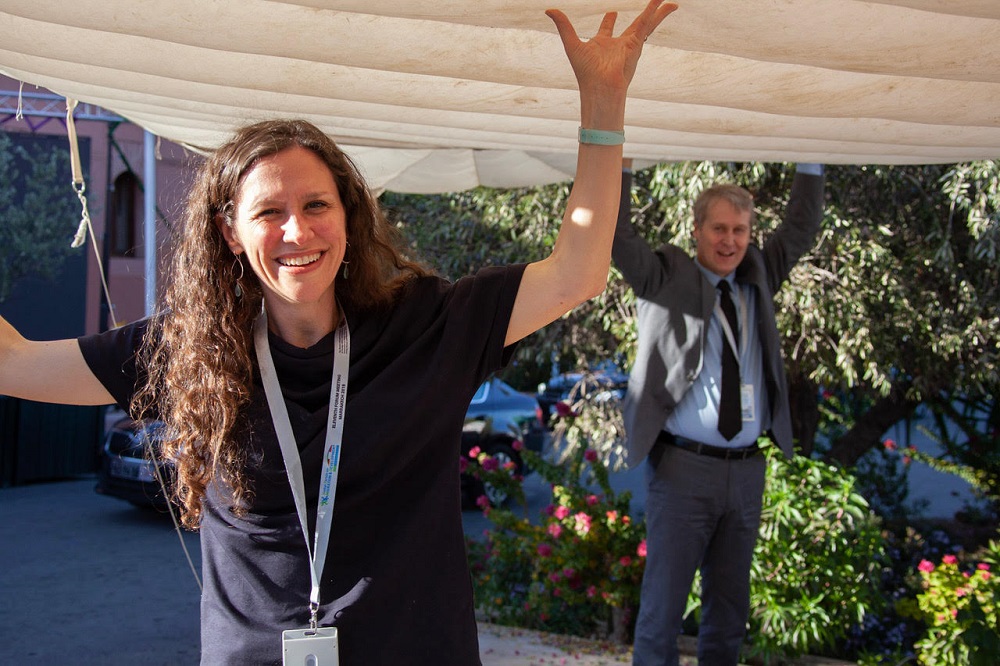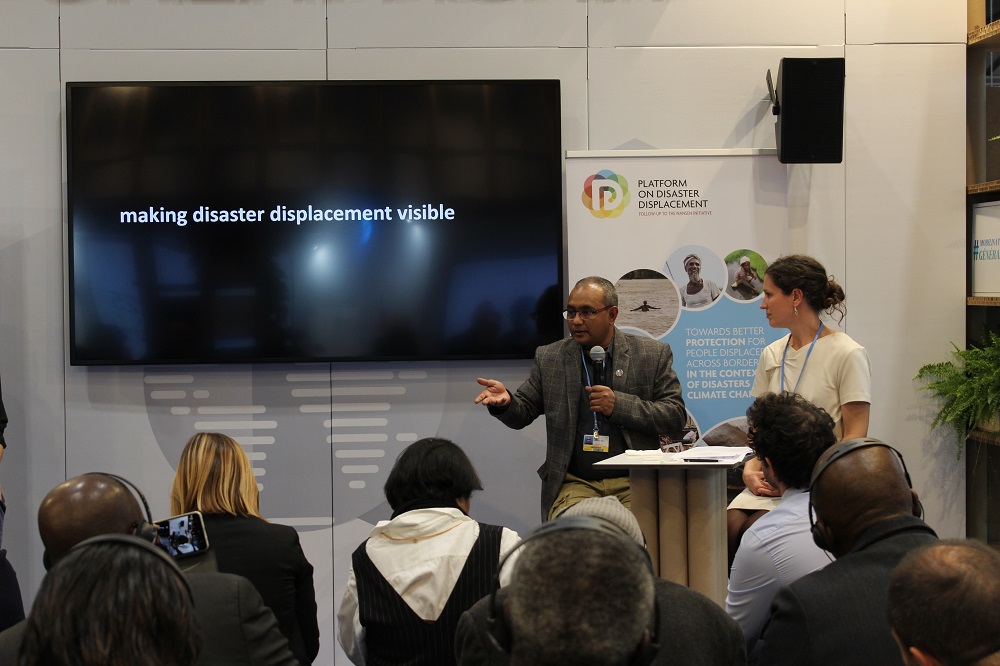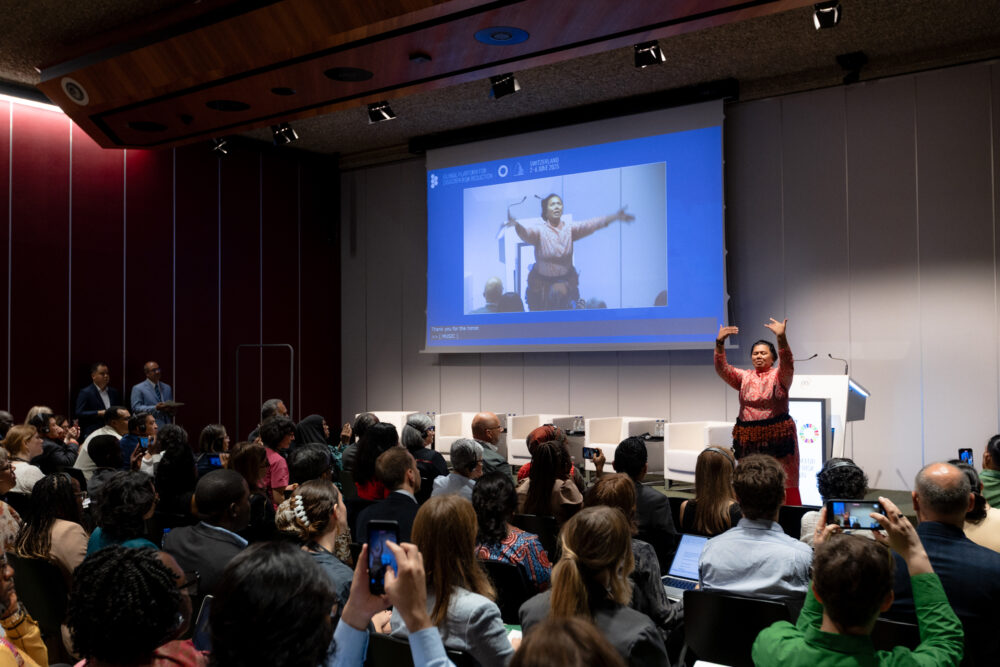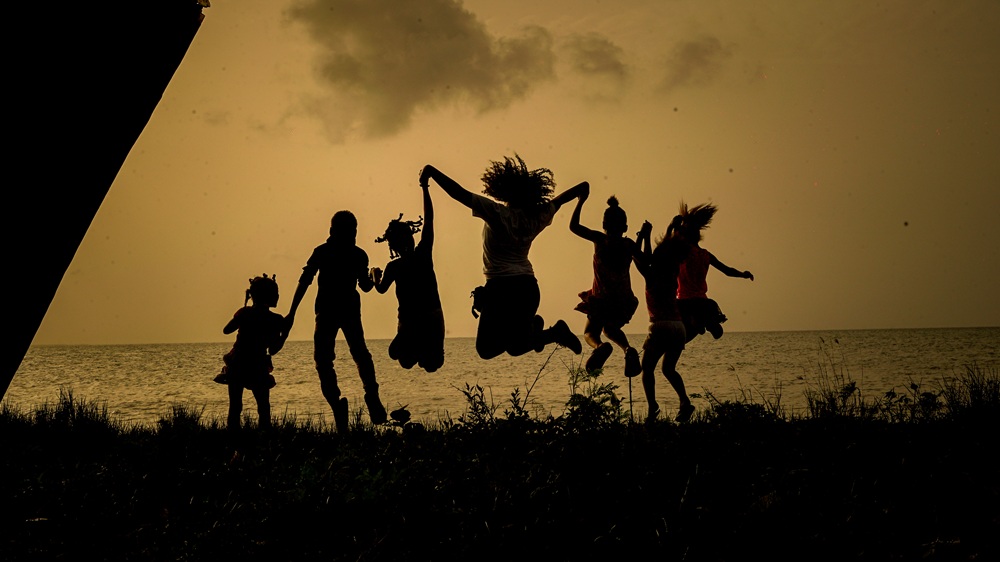“Art can help us understand what is at stake when we speak of disaster displacement, and why policy work to address the issue is so important.”
Art has the potential to eloquently communicate the impact that displacement due to disasters and the adverse effects of climate change can have on human lives. Bringing this emotive aspect to inform international policymaking is no small feat. DISPLACEMENT- Uncertain Journeys is an integrated cultural project that supports the Platform on Disaster Displacement (PDD), using art practice and research to bring issues of disaster displacement to global, regional and national policymakers. Its activities engage government representatives and other policymakers in dynamic discussion about disasters, climate change and displacement through exhibitions and installations, commissioned artwork, cultural dialogues, public events, an online art gallery linked to social media, and publications. Curator Hannah Entwisle Chapuisat talks about her experience with this unique project…
PDD Secretariat: What was your motivation behind starting the project DISPLACEMENT- Uncertain Journeys?
Ms. Hannah Entwisle Chapuisat: DISPLACEMENT- Uncertain Journeys was inspired by a desire to introduce new insights and energy into the way disaster displacement is presented, discussed and understood in international fora. When I joined the Nansen Initiative in 2013 as the Research and Partnerships Officer, I had just completed a Master of Fine Arts at the Geneva University of Art and Design (HEAD- Genève), where I had studied socially engaged art practices through the lens of my background in international law and policy. After working for many years with the UN on displacement and humanitarian response issues, I felt that these art practices were particularly effective at addressing both the factual and emotional elements of displacement. Yet, I was keenly aware that they were absent from international policy debates.
DISPLACEMENT is an experiment in bringing together the two worlds of contemporary art and policymaking to focus more sharply on the human side of disaster displacement. With the support of colleagues from the Nansen Initiative and working together with the late Prof. Chris Wainwright and his team from the University of the Arts London (UAL), we created the DISPLACEMENT project in 2015 as a way to contribute artistic forms of understanding and knowledge to intergovernmental processes addressing disaster displacement.
I am grateful that we have been able to continue the collaboration with the PDD, the Norwegian Refugee Council (NRC), UAL, and others.
PDD Secretariat: Why art? How does art help further the global response to disaster displacement?
Ms. Hannah Entwisle Chapuisat: Artists have the ability to capture complex issues or feelings in images, sound or installations that would take me paragraphs to explain in writing. And even then, I may never achieve the same result.
Artists can build imaginary worlds and play with utopian ideas to explore alternative solutions to address challenges related to disaster displacement. For example, artist Mary Mattingly has built floating, self-sufficient human habitats in works like Swale and Waterpod. The art collective Re-Locate Kivalina has developed the Kivalina Biochar Reactor, a functioning mobile water sanitation system for the indigenous Alaskan community in the village of Kivalina, which is planning to relocate. Art can also help us understand what is at stake when we speak of disaster displacement, and why policy work to address the issue is so important. For instance, artist Amy Balkin collaborates with communities impacted by climate change to create A People’s Archive of Sinking and Melting, which is a physical archive of fragments from human settlements that would need to be abandoned due to sea-level rise.
PDD Secretariat: You have been engaging policymakers through artistic interventions at various international intergovernmental conferences. Could you share some of your experiences with us?
Ms. Hannah Entwisle Chapuisat: In the DISPLACEMENT project, we are looking for immersive and interactive artworks that invite international conference participants to understand disaster displacement in innovative ways. Our exhibition during Migration Week in Marrakesh in December 2018 was particularly exciting. We were able to bring a number of artworks, including Lucy + Jorge Orta’s Antarctic World Passport Bureau and Antarctic Village- No Borders and Søren Dahlgaard’s The Inflatable Island, into the heart of the international conference center. Conference delegates literally lined up to receive a copy of the Ortas’ Antarctica World Passport that would “grant” them visa-free entry into any country in the world. The  passports were the artists’ utopian proposition for cross-border disaster-displaced people. Similarly, delegates carried Dahlgaard’s The Inflatable Island, a giant island made of parachute fabric, as a symbol of the need to find safe homes for all people who may be forced to leave their homes because of climate change. These artworks attracted significant attention and curiosity, allowing for personal exchange and conversation about the importance of disaster displacement within the formal discussion during the Global Forum on Migration and Development and the UN Conference to Adopt the Global Compact on Migration. They also received a lot of attention from the media.
passports were the artists’ utopian proposition for cross-border disaster-displaced people. Similarly, delegates carried Dahlgaard’s The Inflatable Island, a giant island made of parachute fabric, as a symbol of the need to find safe homes for all people who may be forced to leave their homes because of climate change. These artworks attracted significant attention and curiosity, allowing for personal exchange and conversation about the importance of disaster displacement within the formal discussion during the Global Forum on Migration and Development and the UN Conference to Adopt the Global Compact on Migration. They also received a lot of attention from the media.
More recently, during the UN Climate Change Conference (UNFCCC COP25) in Madrid in December 2019, we partnered with the Coalition for Art and Sustainable Development (COAL) in Paris to present the winners of their annual art prize, which this year was dedicated to the theme of “Climate, Disasters and Displacement.” PDD invited the COAL Prize Laureates, Lena Dobrowolska and Teo Ormand-Skeaping, to receive the prize for their project You Never Know, One Day You Too May Become a Refugee from the French Climate Ambassador at the French Pavilion. With COAL, we presented all ten of the COAL prize finalists’ work inside the Blue Zone to negotiators and policy experts during a side event hosted by the Warsaw International Mechanism (WIM)’s Task Force on Displacement and during three dedicated sessions at the French Pavilion. For me, the most rewarding part was the opportunity for Lena and Teo to explain their project to the conference delegates and receive feedback on which issues would be best for their film to tackle.
PDD Secretariat: How do you make use of diverse avenues which may have different audiences – such as government-oriented conferences/workshops, cultural events, research and online curation?
Ms. Hannah Entwisle Chapuisat: DISPLACEMENT is distinct, in that its primary audience is international policymakers rather than the general public. During the conferences, we try to capture those “in-between” moments as delegates move between formal discussions. For instance, during the UN Refugee Agency (UNHCR)’s Annual Consultation with NGOs in 2018, we screened Lars Jan’s film Holoscenes at the beginning and end of a side event on disaster displacement as delegates entered and left the room, reading a statement from the artist during the panel discussion. Artist Søren Dahlgaard and I took the opportunity to present the DISPLACEMENT project on the Ignite Stage during UN Office for Disaster Risk Reduction (UNDRR)’s Global Platform in Geneva in May 2019. We have also participated in the PDD Advisory Committee meetings, exploring how art might contribute to PDD’s overall communication strategy.
 That said, we have done various events targeted at the wider public. For instance, UNDRR commissioned a month-long panel exhibition along the Lake Geneva border to coincide with the Global Platform on DRR in May 2019, which featured the work of nine artists. We maintain a website that shows selected artworks of artists who have participated in the project. I have also presented the DISPLACEMENT project at various cultural events and workshops, such as at the Théâtre de l’Orangerie and a workshop on climate change for art students at HEAD-Genève.
That said, we have done various events targeted at the wider public. For instance, UNDRR commissioned a month-long panel exhibition along the Lake Geneva border to coincide with the Global Platform on DRR in May 2019, which featured the work of nine artists. We maintain a website that shows selected artworks of artists who have participated in the project. I have also presented the DISPLACEMENT project at various cultural events and workshops, such as at the Théâtre de l’Orangerie and a workshop on climate change for art students at HEAD-Genève.
PDD Secretariat: How do you see the project evolving going forward?
Ms. Hannah Entwisle Chapuisat: As our DISPLACEMENT interventions have shown, art is much more than decoration. It can also produce new knowledge, particularly when artists work with interdisciplinary teams across different research areas. For example, in 2014, the Nansen Initiative partnered with Sciences Po’s Experimental Programme in Art and Politics (SPEAP) master’s program. A group of students selected the internal disaster displacement that occurred in coastal France following the deadly 2010 storm known as Xynthia. After months of field research, Indonesian anthropologist Rhino Ariefiansyah and Swiss artist Marie Velardi produced the film ALEA (“natural hazard”), which captured the stories of the displaced people in Vendée, France who could never return home, and proposed imaginary solutions for how the coastal community could better live with disaster risk in the future. For me, ALEA is an excellent example of art research that blends reality and fiction to produce a nuanced, yet poetic, depiction of a specific displacement situation. I would like DISPLACEMENT to continue to explore how commissioned artworks could contribute to research on disaster displacement.
I also want to continue the practice of a formal exchange between artists, policymakers and researchers. We hope to co-host a conference or series of panel discussions, at either universities or in cultural institutions, to bring these worlds together in focused conversations on the potential impact of art’s contribution to international policymaking and future areas of collaboration between art and policy.
Photos: © Gorm Ashurst and PDD Secretariat.
Learn more about DISPLACEMENT: Uncertain Journeys
Learn more about the Norwegian Refugee Council (NRC)
Learn more about the work of Lena Dobrowolska and Teo Ormond-Skeaping
Learn more about the COAL Prize





